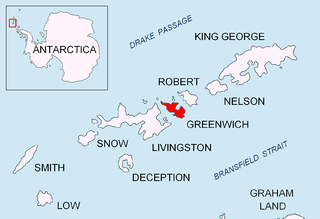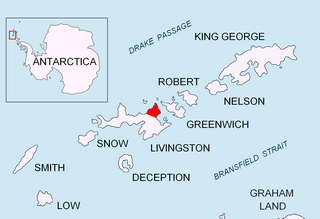
Livingston Island is an Antarctic island in the South Shetland Islands, Western Antarctica lying between the islands of Greenwich and Snow. It was the first land discovered south of 60° south latitude in 1819, an event that marked the end of a centuries-long pursuit of the mythical Terra Australis Incognita and the beginning of the exploration and utilization of real Antarctica. The name Livingston, although of unknown derivation, has been well established in international usage since the early 1820s.

Iskar Glacier is a glacier in Livingston Island, South Shetland Islands in Antarctica situated southeast of lower Huron Glacier, west-southwest of Sopot Ice Piedmont, and north of Dobrudzha and Magura Glaciers. It drains the north slopes of the Tangra Mountains between Helmet Peak to the west and Delchev Peak to the east, and flows northward into Bruix Cove between Yana Point and Rila Point.

Murgash Glacier is the 3.4 km long and 3.2 km wide glacier on Greenwich Island in the South Shetland Islands, Antarctica situated southeast of Yakoruda Glacier, south of Teteven Glacier, southwest of Traub Glacier and west-northwest of Bravo Glacier. It is bounded by Lloyd Hill on the northwest, Tile Ridge on the east and Hebrizelm Hill on the southeast, and drains southwards into Kramolin Cove in McFarlane Strait between Yovkov Point and Kaspichan Point.

Panega Glacier on Varna Peninsula, Livingston Island in the South Shetland Islands, Antarctica is situated southeast of the northeastern portion of Saedinenie Snowfield, south of Rose Valley Glacier, southwest of Debelt Glacier and north of lower Kaliakra Glacier. It drains the southeast slopes of Vidin Heights and flows into Moon Bay between Helis Nunatak and Perperek Knoll. The glacier extends 2 nautical miles in the southeast-northwest direction, and 1.6 nautical miles in the southwest-northeast direction. It is named after Zlatna Panega River in northern Bulgaria.

Perunika Glacier is an 8 km long and 3 km wide (average) roughly crescent-shaped glacier in eastern Livingston Island in the South Shetland Islands, Antarctica situated east of Pimpirev Glacier, south of Saedinenie Snowfield, southwest of Kaliakra Glacier, west of Huron Glacier, and north of Balkan Snowfield and the head of Huntress Glacier.

Pimpirev Glacier on Livingston Island in the South Shetland Islands, Antarctica is situated south of the glacial divide between the Drake Passage and Bransfield Strait, southeast of Tundzha Glacier, southwest of Saedinenie Snowfield, west of Perunika Glacier and east-northeast of Kamchiya Glacier. The feature extends 5.5 km in a southeast-northwest direction, and 1.8 km in northwest-southeast direction. The glacier drains southeastwards towards Pimpirev Beach, mostly terminating on the shore, and on several occasions penetrating the South Bay waters east-northeast of Ereby Point.

The Antarctic Place-names Commission was established by the Bulgarian Antarctic Institute in 1994, and since 2001 has been a body affiliated with the Ministry of Foreign Affairs of Bulgaria.

Letnitsa Glacier is a 0.9 nautical miles long glacier on Smith Island in the South Shetland Islands, Antarctica draining the southeast slopes of Imeon Range east of Organa Peak and south of Riggs Peak. It is situated southwest of Gramada Glacier and northeast of Kremena Ice Piedmont, and flows southeastward into Hisarya Cove, Osmar Strait. Bulgarian early mapping in 2009. The glacier is named after the town of Letnitsa in northern Bulgaria.

Gramada Glacier is a 1.6 nautical miles long glacier on Smith Island in the South Shetland Islands, Antarctica draining the southeast slopes of Imeon Range east of Riggs Peak, southeast of Madan Saddle and south of Neofit Peak. It is situated southwest of Armira Glacier and northeast of Letnitsa Glacier, and flows southeastward into Brashlyan Cove on Osmar Strait. Bulgarian early mapping in 2009. The glacier is named after the town of Gramada in northwestern Bulgaria.

Armira Glacier is a 1.6 nautical miles long glacier on Smith Island in the South Shetland Islands, Antarctica draining the southeast slopes of Imeon Range southeast of Slaveykov Peak and east of Neofit Peak. It is situated southwest of Dragoman Glacier and northeast of Gramada Glacier, and flows southeastward into Yarebitsa Cove on Osmar Strait. Bulgarian early mapping in 2009. The glacier is named after Armira River in southeastern Bulgaria.

Dragoman Glacier is a 1.4 nautical miles long glacier on Smith Island, South Shetland Islands draining the southeast slopes of Imeon Range southeast of Zavet Saddle and south of the summit Mount Foster. It is situated southeast of Bistra Glacier, southwest of Landreth Glacier and northeast of Armira Glacier, and flows southeastward into Ivan Asen Cove, Osmar Strait. Bulgarian early mapping in 2009. The glacier is named after the town of Dragoman in western Bulgaria.

Rupite Glacier is a 1.6 nautical miles long glacier on Smith Island, South Shetland Islands draining the southeast slopes of Imeon Range east of the summit Mount Foster and southeast of Evlogi Peak. It is situated southeast of Chuprene Glacier, southwest of Pashuk Glacier and northeast of Landreth Glacier, and flows southeastward into Osmar Strait. Bulgarian early mapping in 2008. The glacier is named after the settlement Rupite and the nearby protected area in southwestern Bulgaria.

Krivodol Glacier is a 3.8 km long glacier on Smith Island, South Shetland Islands in Antarctica draining the southeast slopes of Imeon Range northeast and east of Antim Peak, southeast of Varshets Saddle and south of Slatina Peak. It is situated southwest of Ovech Glacier and northeast of Pashuk Glacier, and flows southeastward into Osmar Strait northeast od Sredets Point. Bulgarian early mapping in 2008. The glacier is named after the town of Krivodol in northwestern Bulgaria.

Ovech Glacier is a 3.5 km long glacier on Smith Island, South Shetland Islands draining the southeast slopes of Imeon Range southeast of Drinov Peak and east of Popovo Saddle and Sevlievski Peak. It is situated southeast of Vetrino Glacier and Yablanitsa Glacier, and northeast of Krivodol Glacier, and flows east-southeastward into Nikolov Cove on Boyd Strait. Bulgarian early mapping in 2009. The glacier is named after the medieval fortress of Ovech in northeastern Bulgaria.

Saparevo Glacier is a 1.8 km long and 2 km wide glacier draining the northwest slopes of Imeon Range on Smith Island, South Shetland Islands, Antarctica. It is situated northeast of Kongur Glacier, and flows north-northeast of Mount Christi and southwest of Matochina Peak into Vedena Cove in Drake Passage. Bulgarian early mapping in 2009. The glacier is named after the settlement of Saparevo in Southwestern Bulgaria.

Kongur Glacier is a 1.4 nautical miles long glacier draining the northwest slopes of Imeon Range on Smith Island in the South Shetland Islands, Antarctica. It is situated northeast of Dalgopol Glacier and southwest of Saparevo Glacier, and flows west of Mount Christi into Drake Passage. Bulgarian early mapping in 2009. The glacier is named after the peak and nature reserve of Kongur on Belasitsa Mountain in southwestern Bulgaria.

Dalgopol Glacier is a 1.8 nautical miles long glacier draining the northwest slopes of Imeon Range on Smith Island in the South Shetland Islands, Antarctica. It is situated northeast of Vetrino Glacier and southwest of Kongur Glacier, and flows north of Mount Pisgah and northwest of Mezek Peak into Drake Passage. Bulgarian early mapping in 2009. The glacier is named after the town of Dalgopol in northeastern Bulgaria.

Yablanitsa Glacier is a 1.8 km long glacier on Smith Island in the South Shetland Islands, Antarctica. It is situated north-northeast of Chuprene Glacier, southwest of Vetrino Glacier and northwest of Ovech Glacier, and flows west of Drinov Peak into Cabut Cove. The feature is named after the town of Yablanitsa in northern Bulgaria.

The Larsemann Hills are a series of low rounded coastal hills along the southeastern shore of Prydz Bay, Antarctica extending for 9 nautical miles (17 km) from Dålk Glacier. They were discovered in February 1935 by Captain Klarius Mikkelsen from the whaling ship Thorshavn, sent out by Norwegian whaling magnate Lars Christensen, and given this name.











